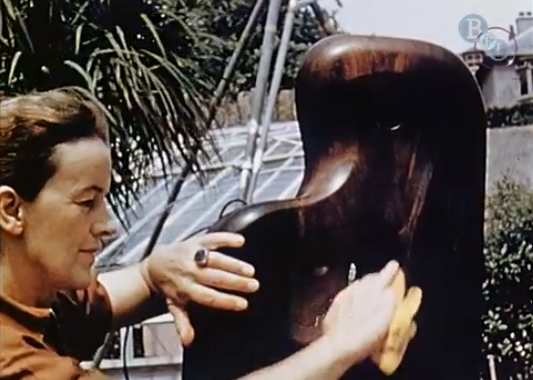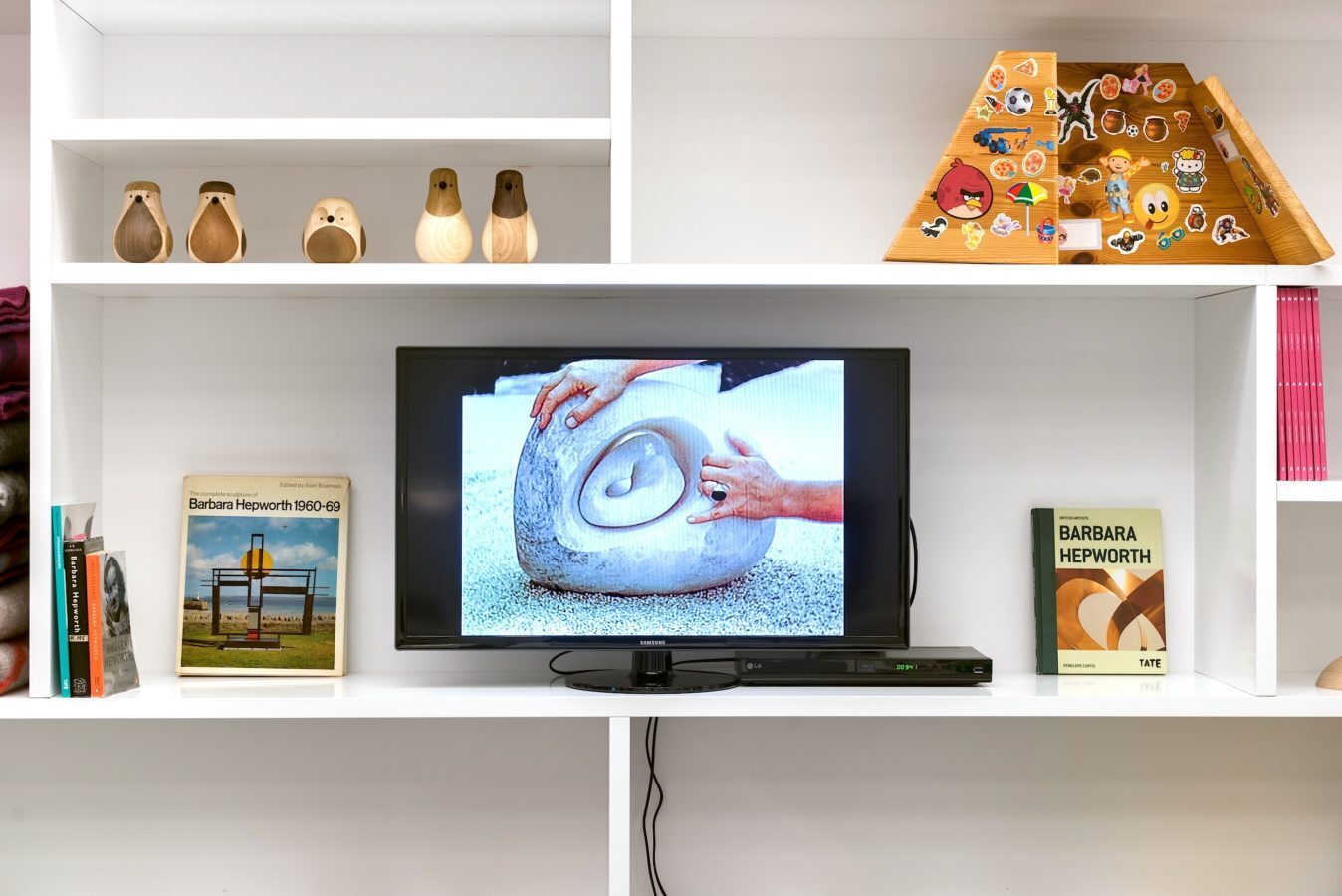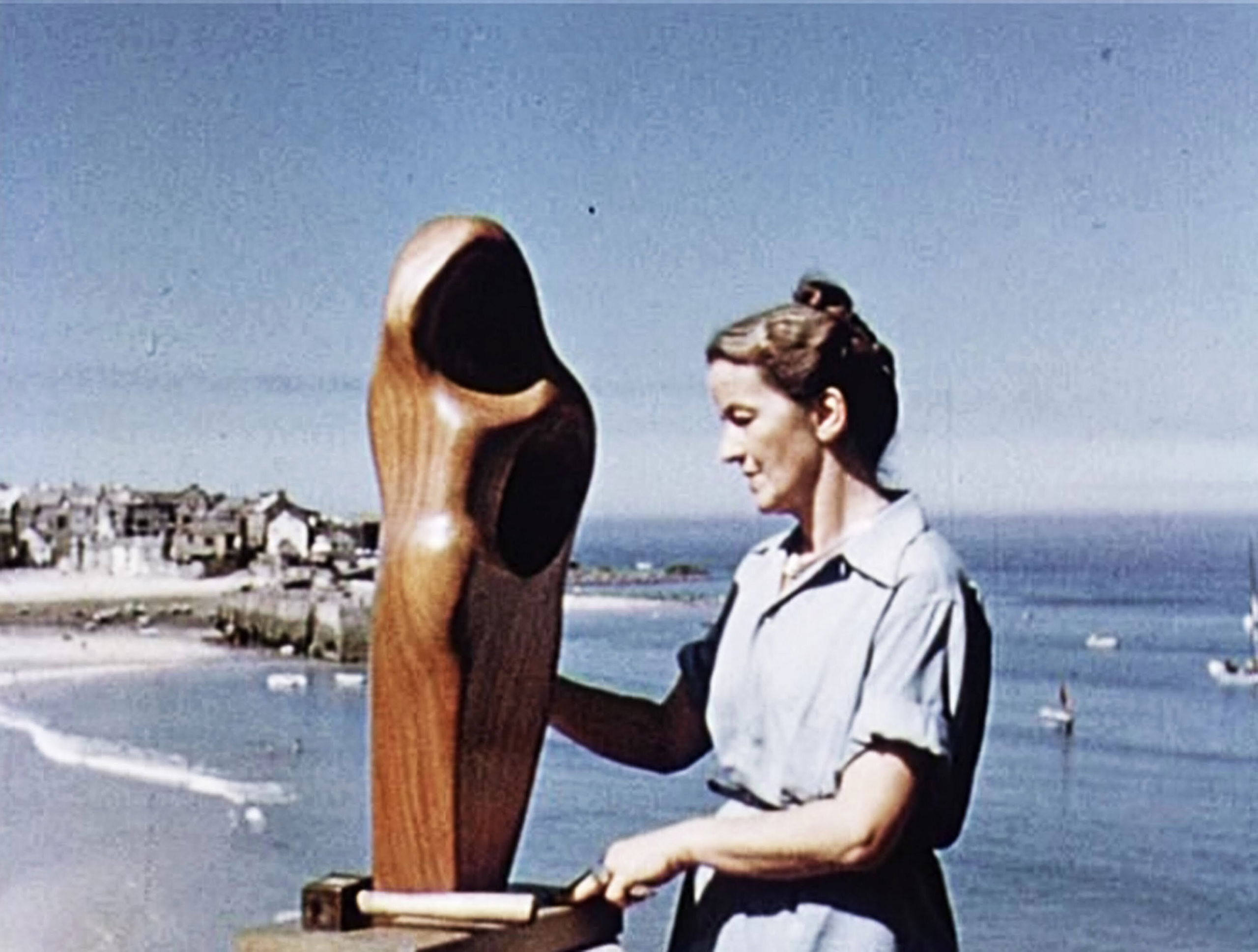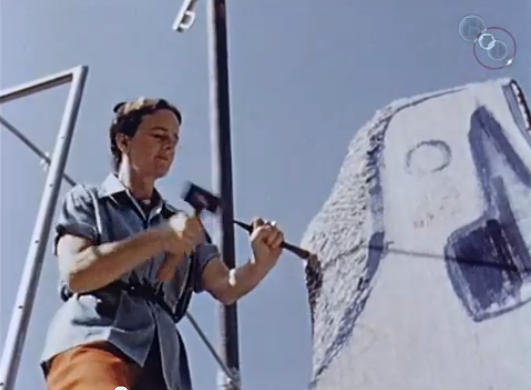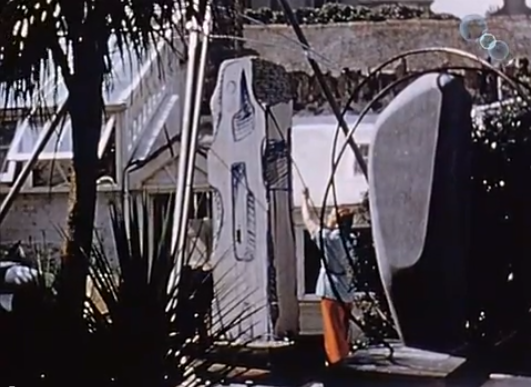
At over two and a half metres high (eight and a half feet) Figure for Landscapeis a substantial presence. It was made during a period in which Barbara Hepworth undertook a series of commissions for bronzes which were architectural in scale and setting; they included Meridian, 1958-60 (BH 250) in London, related to Garden Sculpture (Model for Meridian) (Tate Gallery T03139), and Single Form, 1961-4 (BH 325) in New York related to Single Form (September)(Tate Gallery T03143). Although sharing some of their monumental character, Figure for Landscape remained within the physical limitations of manufacture in her workshop and - as the title announces - within the context of nature.
Around the time of making the sculpture, Hepworth discussed the associations between her work and landscape which were of long-standing importance. She explained to Edouard Roditi that a sculpture 'is for
At over two and a half metres high (eight and a half feet) Figure for Landscapeis a substantial presence. It was made during a period in which Barbara Hepworth undertook a series of commissions for bronzes which were architectural in scale and setting; they included Meridian, 1958-60 (BH 250) in London, related to Garden Sculpture (Model for Meridian) (Tate Gallery T03139), and Single Form, 1961-4 (BH 325) in New York related to Single Form (September)(Tate Gallery T03143). Although sharing some of their monumental character, Figure for Landscape remained within the physical limitations of manufacture in her workshop and - as the title announces - within the context of nature.
Around the time of making the sculpture, Hepworth discussed the associations between her work and landscape which were of long-standing importance. She explained to Edouard Roditi that a sculpture 'is for a specific landscape. My own awareness of the structure of the landscape ... provides me with a kind of stimulus. Suddenly an image emerges clearly in my mind, the idea of an object that illustrates the nature or quality of my response' (Edouard Roditi, Dialogues on Art, 1960, p.92). This related to Hepworth's view of the figure's emergence from and integration with the landscape. She recalled glimpsing an isolated priest on the Greek island of Patmos:
This single human figure then seemed to me to give the scale to the whole universe, and this is exactly what a sculpture should suggest in its relationship to its surroundings: it should seem to be at the centre of the globe, compelling the whole world around it to rotate, as it were, like a system of planets around a central sun.
(ibid., p.101)
Hepworth also saw some of this quality in the relationship of the Neolithic stones to the landscape of Cornwall: 'Any standing stone in the hills here is a figure, but you have to go further than that ... To resolve the image so that it has something affirmative to say is to my mind the only point' (Bowness 1971, p.13). These conceptual threads - of placement within a specific location and a compelling relationship to it - evolved in Hepworth's earlier works, such asCurved Form (Trevalgan) (Tate Gallery T00353), which offered an abstract response to the feeling of being in a particular landscape. That these ideas are channelled into Figure for Landscape is acknowledged in the explicitly figural reference of the title, even as the vertical form evokes that of such abstractions as Single Form (Eikon), 1937-8 (Tate Gallery T00697). The quality of an enclosed but rising form suggests the emergence of the sculptural object from the landscape to which she also alluded (ibid., p.14).
This enclosure continues the artist's preferred hollowing to allow light to enter the solid form. It is significant that Hepworth described this process as conveying 'a sense of being contained by a form as well as of containing it' (Roditi, Dialogues on Art, 1960, p.100). In relation to the over life-size Figure for Landscapesuch an analogy suggests the 'allusions to the womb and to the caring, sheltering function of the mother' that Claire Doherty has recognised in other sculptures by Hepworth (Claire Doherty, 'Re-reading the Work of Barbara Hepworth in the Light of Debates on "the Feminine"' in David Thistlewood (ed.), Barbara Hepworth Reconsidered, 1996, p.168). It may also encourage an extension of the interpretation of her pre-war sculpture in the light of Melanie Klein's psychoanalytic theory of art as a reparative act for the infantile desire to attack the mother's womb (Anne M. Wagner, ' "Miss Hepworth's Stone Isa Mother" ', ibid., pp.65-8).
The hollowing of the sculpture was a standard practice for Hepworth's carvings, but Figure for Landscapewas the first in which this wrapping was attempted in plaster for bronze. The exactly contemporary marble Image II(Tate Gallery T00958) and guarea Epidauros(Tate GalleryT03141) show her stylistic diversity and how far the forms were modified in response to the qualities of the different materials. The particular balance inFigure for Landscape also suggests comparisons with the work of others. The equation of landscape and figure - especially in an enfolding form - was a central concern of Henry Moore, for whom it took on a specifically female embodiment in the hollowed shell of Reclining Figure (External Form), 1953-4 (Art Institute of Chicago, repr. Alan Bowness, ed., Henry Moore, Volume 2: Sculpture and Drawings, 1949-54, 2nd ed. 1965, LH 299, pl.28). However, the monumental aspect also evokes Auguste Rodin's famously self-possessed Balzac, 1892-7 (Carrefour Vavin, Paris, repr. Ionel Jianou and C. Goldscheider, Rodin, Paris 1969, pl.86), in which the figure is wrapped in a gown. This similarity encouraged Herbert Merillat to remark that the Hepworth was 'definitely human in contour, suggesting a mummy case' (Merillat 1974, p.113). In the preceding years there were other examples of contemporaries working with similar qualities of enclosure. More pertinent to the opening of the interior is Arp's abstract Ptolemy I, 1953 (Fondation Arp, Clamart) in which space is held by diagonally encircling forms; an illustration of Arp's sculpture served as a frontispiece for Herbert Read's The Art of Sculpture(1954, repr. [p.iv]) of which Hepworth was a joint dedicatee (with Moore and Gabo). Hepworth herself continued to explore the themes and processes undertaken in Figure for Landscape, in Sea Form (Atlantic), 1964 (BH 362, Museum of Fine Arts, Dallas, repr. Bowness 1971, pls.103,104) and Rock Form (Porthcurno), 1964 (BH 363, Cornwall County Council, repr. ibid., pls.105,106). Each explored the identification of figure and landscape through the penetration of an upright, vaguely figurative, mass by openings rather than the enclosure used for the earlier sculpture.
In making Figure for Landscape, plaster was applied to an expanded aluminium armature, following the method established since 1956. Amongst her assistants, Brian Wall recalled making the armature (interview with the author, 3 May 1996) and Tommy Rowe remembered helping Hepworth to apply the plaster (interview with the author, 16 Oct. 1996). It appears to have had two curved cross-braces to provide additional strength: the broad strut which intrudes above the lower hole in the back and the diagonal strip that bridges the front opening. The plaster was generously and vigorously applied, securing a richly textured surface that was then carved; this was the process that the artist explained in a contemporary letter to Herbert Read (29 Oct. 1961, Sir Herbert Read Archive, University of Victoria, B.C.). The shoulders of the form particularly show this carving. In profile, the back appears to be quite flat so that, in common with many of Hepworth's sculptures, the primary effect is frontal.
The casting of the bronze was subject to delay. The sculptor had to distribute works to different foundries in order to get them completed during the run-up to her 1960 Zurich exhibition (Galerie Charles Lienhard). In September 1959 she had asked Morris Singer Ltd if they had time to cast an unspecified 'large bronze say 6-7 feet, to be ready by the end of next March' (Hepworth to Morris Singer Ltd., 21 Sept. 1959, TGA 965). By November their schedules prevented casting 'my seven foot figure' (Hepworth to Morris Singer Ltd., 2 Dec. 1959, TGA 965). As she told Read: 'There remains but one now - a 7 ft [sic] figure - which so far I haven't been able to persuade anybody to do for me, as the foundries are booked up' (1 Dec. 1959, Sir Herbert Read Archive, University of Victoria, B.C.). Eventually Morris Singer Ltd cast it in 1961, 1/7 being completed by September (Hepworth to Morris Singer Ltd., 20 Sept. 1961, TGA 965). This was the artist's copy - which came to the Tate - and it was patinated green, with greater intensity on the inner faces. Although it was listed in her solo exhibition in London (Barbara Hepworth, Gimpel Fils, May-June 1961, no.18), it was feared that it would not fit in the gallery (Kay Gimpel to Hepworth, 7 March 1961, TGA 965), and their records note it as 'not shown'.
Nevertheless, it did appear in subsequent exhibitions and in 1968, the year of the artist's major retrospective at the Tate Gallery, two further casts passed into public collections: the San Diego Society of Arts (5/7) and the Stavanger Kunstforening, Norway (6/7). Earlier casts are in the Hirshhorn Museum and Sculpture Garden, Smithsonian Institution, Washington D.C. (2/7) and Exeter University (4/7).
The size of the plaster had dictated that the hollow cast bronze had to be made in two parts. An inspection of the Tate's sculpture in 1983 revealed that the parts were bolted together with several bronze and five mild steel bolts which had rusted. Timber formers under the flared out base had also rotted and they, together with remains of moulding sand from inside the sculpture, were removed (Tate Gallery Conservation Records). The old drainage hole in the bottom of the sculpture had probably been blocked to arrest the appearance of iron staining from the inner bolts. A new drainage hole was made in 1983, and fitted with a gauze mesh set in 'Dow Corning' silicone rubber and attached to a pipe. The sculpture has weathered as a result of its position in the artist's garden; the perennial problems remain handling and leaf deposits, weather and bird lime. As a result of the 1983 inspection the surface was cleaned in preparation for the application of two coats of lacquer, the second including a matting agent. Lacquer proved hard to detect on a subsequent inspection and small areas of bronze disease have been noted (Tate Gallery Conservation Records).
b. 1903
Dame Barbara Hepworth var en av modernismens viktige kunstnere, og en av de første som begynte å jobbe med abstrakte skulpturer i England. Hun ble født i 1903 i Wakefield, England, og bestemte seg for å bli kunstner når hun var 15 år gammel. Hun studerte på Leeds Scool of Art og Royal College of Art i London, hvor Henry Moore var hennes studiekamerat. Hennes lyriske former og gode materialfølelse gjorde henne til en av de mest innflytelsesrike skulptørene i det 20. århundret.
Hepworths fokus var på gigantiske skulpturer, som hun formet og produserte selv, uten skisser. Hun sa at hun ville at tilskueren skulle identifisere seg med skulpturene hennes, og "gi dem et klapp". Et av hennes mest prestisjetunge arbeider er Single Form (1961), som står permanent utenfor FN-bygningen i New York til minne om generalsekretær Dag Hammarskjold. Hun deltok på utstillinger med bla.a Mondrian, Kandinsky, Arp, Giacometti, Miró, Calder, og Moholy-Nagy. Hepworths hus og studio i Cornwall har blitt gjort om til Barbara Hepworth Museum. Et annet museum dedikert til Hepworth, The Hepworth Wakefield, åpnet i 2011 i Wakefield. Tate eier en rekke av hennes arbeider.
Hepworth ble hedret som Dame Commander of the Order of the British Empire i 1965, og A Pictoral Autobiography ble utgitt i 1970 og re-utgitt i 1989. Hun døde i en brann i studioet hennes i Cornwall i 1975.





